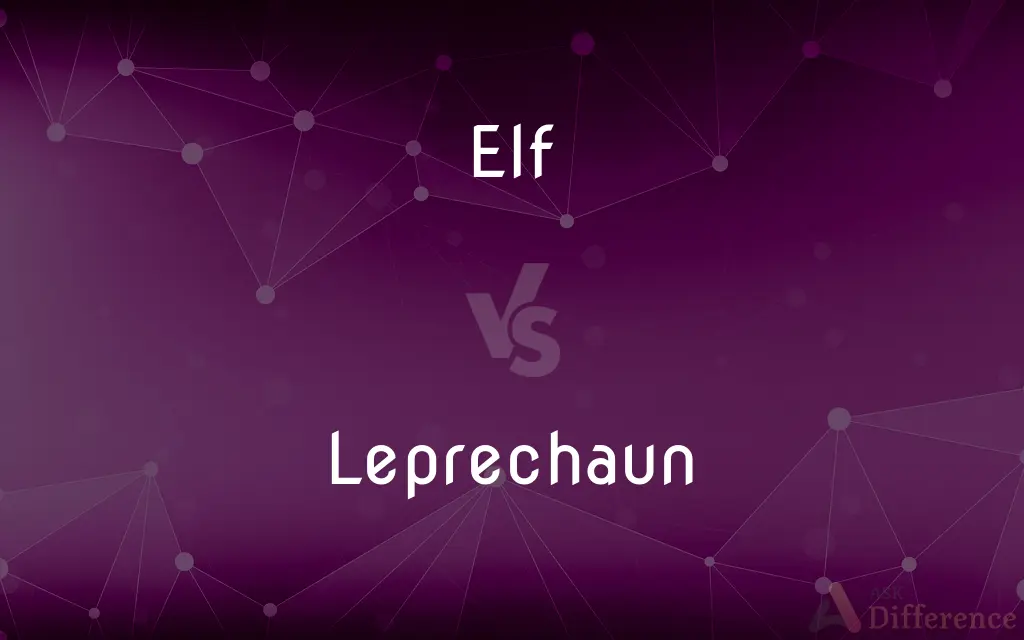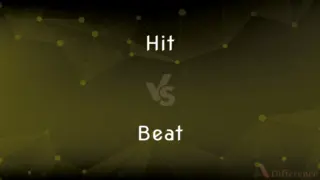Elf vs. Leprechaun — What's the Difference?
Edited by Tayyaba Rehman — By Fiza Rafique — Updated on March 7, 2024
Elves are mythical beings with origins in Germanic folklore, often depicted as youthful, immortal creatures. Leprechauns are a type of fairy in Irish mythology, known for their solitary nature and association with treasure.

Difference Between Elf and Leprechaun
Table of Contents
ADVERTISEMENT
Key Differences
Elves originate from Germanic folklore and are featured in various mythologies and fantasy literature. They are often depicted as beautiful, immortal, and possessing magical powers. Leprechauns, on the other hand, come from Irish mythology and are characterized as small, bearded men who are cobblers by trade and keep hidden pots of gold.
While elves are depicted in a wide range of roles, from benevolent protectors of nature to skilled warriors, leprechauns are primarily known for their trickery and elusiveness, often using clever means to protect their treasures. Elves are typically associated with natural elements and magical realms, appearing as guardians of forests and animals. Leprechauns, however, are more closely tied to the craft of shoemaking and the accumulation of wealth, often through magical or secretive means.
Elves have been romanticized in modern fantasy literature and are key figures in many epic tales, often portrayed with ethereal beauty and grace. Leprechauns remain a symbol of Irish folklore, embodying the themes of luck and fortune, and are popularly featured in celebrations like St. Patrick's Day.
Cultural significance also differentiates these beings; elves are integral to the mythologies of various European cultures and have evolved into iconic figures in fantasy fiction. Leprechauns maintain a strong connection to Irish culture and identity, representing a playful and mischievous aspect of Ireland's mythological tradition.
Both elves and leprechauns have been adapted and reimagined in various forms of media, from literature to films and video games, each retaining core aspects of their mythological origins while being shaped to fit contemporary narratives and genres.
ADVERTISEMENT
Comparison Chart
Origin
Germanic folklore
Irish mythology
Depiction
Youthful, beautiful, magical beings
Small, bearded men, cobblers by trade
Roles
Protectors, warriors, nature guardians
Tricksters, protectors of treasure
Cultural Tie
European mythologies, fantasy literature
Irish culture, folklore
Modern Portrayal
Fantasy fiction, films, video games
St. Patrick's Day, Irish-themed media
Compare with Definitions
Elf
Elves are celebrated in various cultural festivals and fantasy genres.
The festival featured a parade with participants dressed as elves.
Leprechaun
A type of fairy in Irish mythology, often associated with cobbling and treasure.
Leprechauns are often depicted mending shoes and hiding their gold at the end of rainbows.
Elf
Mythical beings from Germanic folklore, often associated with magic and nature.
Elves are known for their grace and are often depicted as guardians of the forest.
Leprechaun
Symbolize luck and fortune in Irish folklore.
Finding a leprechaun's pot of gold is considered extremely lucky.
Elf
Elves have magical abilities in many tales.
The elf used his magic to heal the wounded animal.
Leprechaun
Known for their mischievous nature and trickery.
The leprechaun outwitted the man trying to steal his gold.
Elf
Elves are central characters in many fantasy settings.
In the game, players could choose elves as their character race, known for their agility and magical prowess.
Leprechaun
Celebrated and symbolized during St. Patrick's Day.
Leprechaun costumes and imagery are prevalent in St. Patrick's Day parades.
Elf
In literature, elves are depicted as wise and immortal beings.
The elves in the story were skilled archers and lived in harmony with nature.
Leprechaun
Leprechauns are often depicted in tales as solitary creatures.
The leprechaun lived alone, hidden away with his pot of gold.
Elf
An elf (plural: elves) is a type of humanoid supernatural being in Germanic mythology and folklore (especially North Germanic mythology and folklore). In medieval Germanic-speaking cultures, elves generally seem to have been thought of as beings with magical powers and supernatural beauty, ambivalent towards everyday people and capable of either helping or hindering them.
Leprechaun
A leprechaun (Irish: leipreachán/luchorpán) is a diminutive supernatural being in Irish folklore, classed by some as a type of solitary fairy. They are usually depicted as little bearded men, wearing a coat and hat, who partake in mischief.
Elf
A mythical creature in human form but usually smaller, often considered mischievous.
Leprechaun
In Irish folklore, a mischievous elflike creature or fairy who grants wishes or reveals the location of hidden treasure when captured.
Elf
A lively, mischievous child.
Leprechaun
(Irish folklore) One of a race of elves that can reveal hidden treasure to those who catch them.
Elf
A usually sprightly or mischievous or sometimes spiteful person.
Leprechaun
A small mischevous elf or spirit in Irish folklore; it is often depicted in literature as a dwarfish bearded old man; - legend tells that if a leprechaun is captured, he will reveal the location of his hidden pot of gold.
Elf
(Norse mythology) A luminous spirit presiding over nature and fertility and dwelling in the world of Álfheim (Elfland). Compare angel, nymph, fairy.
Leprechaun
A mischievous elf in Irish folklore
Elf
Any from a race of mythical, supernatural beings resembling but seen as distinct from human beings. They are usually delicate-featured and skilled in magic or spellcrafting; sometimes depicted as clashing with dwarves, especially in modern fantasy literature.
Elf
(fantasy) Any of the magical, typically forest-guarding races bearing some similarities to the Norse álfar (through Tolkien's Eldar).
Elf
A very diminutive person; a dwarf.
Elf
(South Africa) The bluefish (Pomatomus saltatrix).
Elf
To twist into elflocks (of hair); to mat.
Elf
An imaginary supernatural being, commonly a little sprite, much like a fairy; a mythological diminutive spirit, supposed to haunt hills and wild places, and generally represented as delighting in mischievous tricks.
Every elf, and fairy sprite,Hop as light as bird from brier.
Elf
A very diminutive person; a dwarf.
Elf
To entangle mischievously, as an elf might do.
Elf all my hair in knots.
Elf
(folklore) fairies that are somewhat mischievous
Elf
Below 3 kilohertz
Common Curiosities
Are elves always depicted as good beings?
Elves are often depicted positively, but variations in folklore and literature also present them as neutral or even malevolent beings.
How have modern interpretations of elves and leprechauns differed from traditional folklore?
Modern interpretations often romanticize elves as noble and ethereal beings in fantasy fiction, while leprechauns are popularly featured in a more playful and whimsical context, especially in relation to St. Patrick's Day.
Can elves and leprechauns be considered the same type of mythical creature?
No, they originate from different cultural mythologies and have distinct characteristics and roles within their respective folklore.
What are the key differences between elves and leprechauns?
Elves are mythical beings from Germanic folklore known for their beauty and magical abilities, while leprechauns are Irish fairy folk characterized by their cobbling, trickery, and hidden treasures.
Is the pot of gold associated with leprechauns based on a specific Irish legend?
The pot of gold is a popular element in leprechaun folklore, often used to depict the creatures' wealth and the desire of humans to capture them for their treasure, though specific origins of the legend vary.
Do leprechauns possess magical powers?
Yes, leprechauns are often depicted with magical abilities, particularly related to their ability to hide or protect their treasures.
Are there different types of elves in folklore?
Yes, folklore and literature describe various types of elves, ranging from woodland elves connected to nature to high elves known for their wisdom and magical abilities.
How have elves and leprechauns influenced contemporary media?
Elves and leprechauns have been widely adapted in literature, movies, and games, influencing fantasy genres and contributing to cultural celebrations, with each retaining core aspects of their mythological roots while being shaped to fit modern narratives.
What is the cultural significance of elves in European mythology?
Elves hold significant roles in various European mythologies, often associated with nature, magic, and the supernatural, reflecting the cultures' connection to the natural world and the mystical.
How do leprechauns reflect Irish culture and identity?
Leprechauns embody aspects of Irish folklore and tradition, reflecting themes of luck, wealth, and the whimsical nature of Irish storytelling.
Share Your Discovery

Previous Comparison
Maximin vs. Minimax
Next Comparison
Hit vs. BeatAuthor Spotlight
Written by
Fiza RafiqueFiza Rafique is a skilled content writer at AskDifference.com, where she meticulously refines and enhances written pieces. Drawing from her vast editorial expertise, Fiza ensures clarity, accuracy, and precision in every article. Passionate about language, she continually seeks to elevate the quality of content for readers worldwide.
Edited by
Tayyaba RehmanTayyaba Rehman is a distinguished writer, currently serving as a primary contributor to askdifference.com. As a researcher in semantics and etymology, Tayyaba's passion for the complexity of languages and their distinctions has found a perfect home on the platform. Tayyaba delves into the intricacies of language, distinguishing between commonly confused words and phrases, thereby providing clarity for readers worldwide.
















































